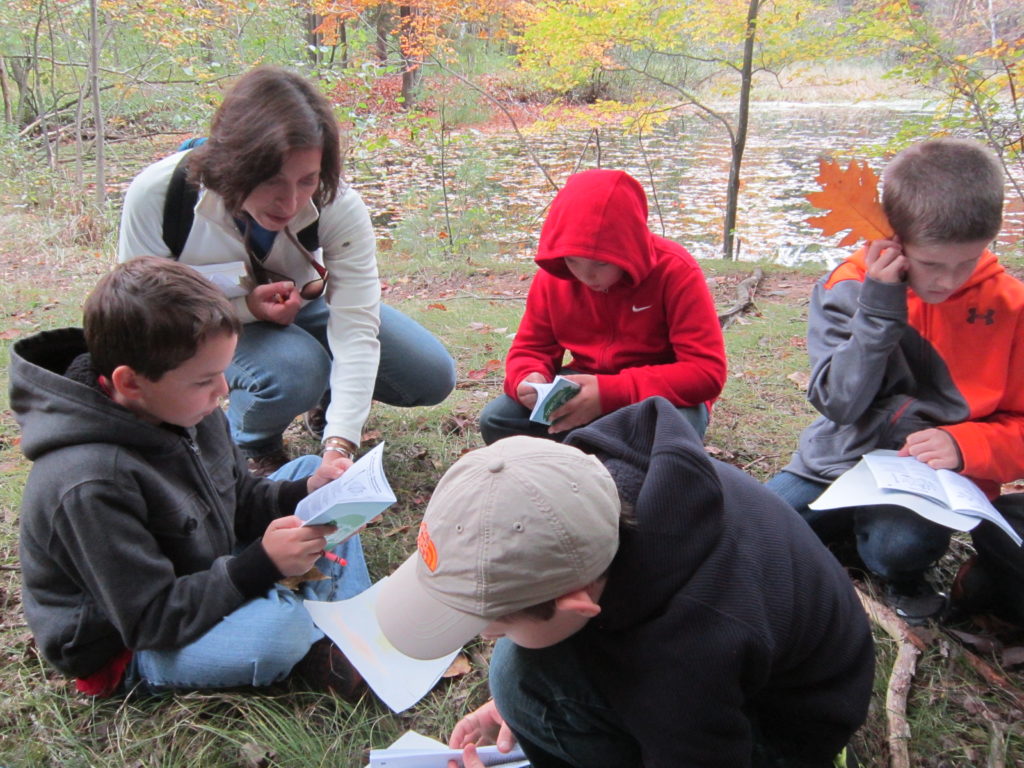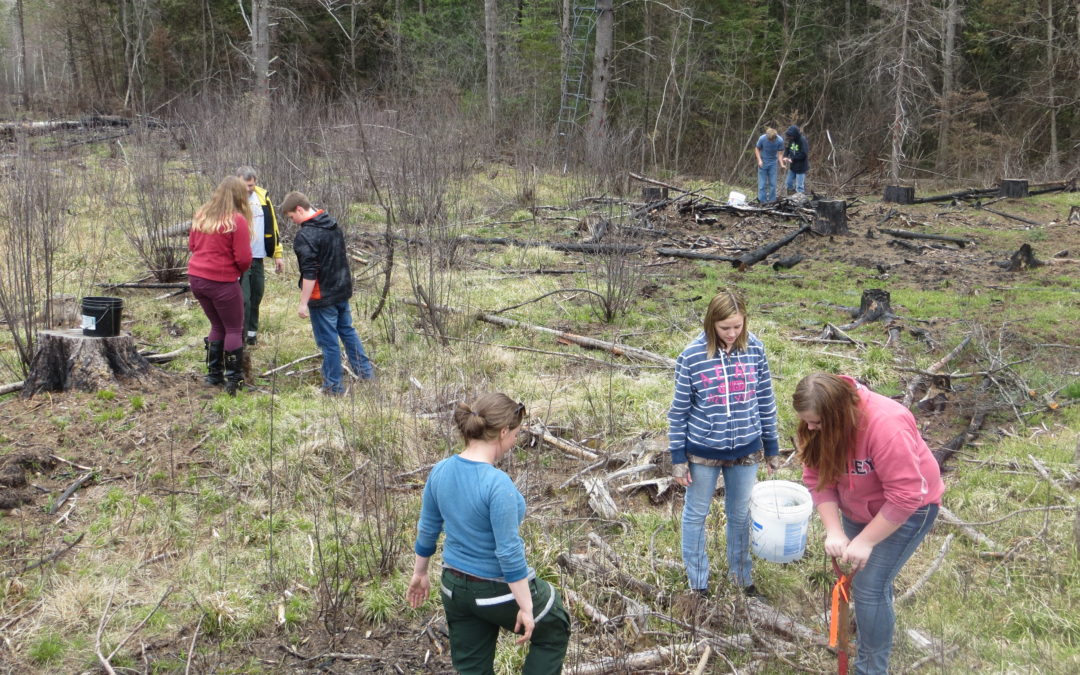By. Cyndy Merse, GSNN Content Writer
The humble tree confers many benefits to humans and the environment: it offers shade and shelter from the sun, helps cool urban centers, is a home and food source for wildlife, and reduces erosion and soil loss in runoff prone areas. It is no wonder, then, that forests are highly prized habitats, sustaining life and livelihoods. Forests also serve as ideal learning environments for students of all ages, and their highly complex ecosystem promises many opportunities for teaching about the natural world as well as other core subjects. The state of Wisconsin has taken the idea of the forest classroom one step further with its state-wide school forest program. Through this program, schools are infusing forestry education into their curriculum and teaching students to be responsible stewards of forests using smart, sustainable management techniques.
A Brief History of Wisconsin School Forests
What exactly is a school forest? According to the school forest program website:
“A school forest is land registered through the state community forest program and owned or controlled by a public or private school and used for environmental education and natural resource management.”
The idea for school forests was borne out of a need to restore land that had been over-harvested and was unsuitable for farming. While on a trip to Australia in 1925, Dean Russell of the University of Wisconsin’s College of Agriculture witnessed schoolchildren planting trees on public land as part of an education project. Inspired, he brought the idea back to Wisconsin in the hope it could be implemented there.
In 1927, Mr. Russell led an effort to develop legislation that permitted school districts to own land for forestry programs. With support from Wakelin McNeel, an early school forest visionary, and Fred Trenk, a University of Wisconsin Extension Forester, the state was able to adopt school forests as a way to jumpstart an aggressive reforestation program. Within the year, three tracts of land were donated or purchased for use as school forests. These tracts were officially dedicated in the spring of 1928, making Wisconsin’s state forest program the first of its kind in the nation.
A couple of additional milestones in the history of Wisconsin’s school forests include:
- Legislation passed in 1935 mandated the integration of conservation education into curriculum taught at high schools, vocational schools, universities, and colleges. School forests assumed a new role as outdoor classrooms, providing students with environmental education opportunities, as well as venues for practicing sustainable natural resource management.
- A revision of Wisconsin’s school forest statutes in 1949 enabled schools to become eligible to receive free tree seedlings from state forest nurseries and to work with foresters to develop forest management plans.

Newman Catholic School Forest BioBlitz in September 2014.
Photo| Gretchen Marshall
School Forests in Wisconsin Today
School forests continue to play a vital role in K-12 education in Wisconsin. The school forest program is administered under Wisconsin’s K-12 Forestry Education Program, LEAF (Learning, Experiences, and Activities in Forestry), which is a partnership program between the Wisconsin Department of Natural Resources – Division of Forestry and the University of Wisconsin-Stevens Point’s Wisconsin Center for Environmental Education. The state-level program serves as a resource for school districts who manage their forests on an individual basis. As of May 2016, there were 421 registered school forest parcels in use by 240 school districts, with parcels ranging in size from 1 – 700 acres.
When the school forest program was established in 1928, the goal was to encourage student involvement in replanting forests and instill a conservation ethic in Wisconsin’s youth. Since that time, the goals of the program have evolved to utilize the forests as outdoor education sites that:
- Integrate environmental education into school curriculum;
- Provide experiential learning;
- Meet state education standards;
- Demonstrate sustainable natural resource management;
- Strengthen school-community relations; and
- Provide income for education-related activities.
In 2003, Wisconsin affirmed its commitment to its school forest program by establishing a statewide school forest coordinator. The coordinator assists school districts by:
- Providing guidance and consultation in developing school forest programs and education plans.
- Connecting schools with forest management resources.
- Networking and providing information for educators.
- Offering professional development for educators, administrators, and natural resource managers.
- Providing information about funding sources and education resources.
The Forest Classroom
School forests present teachers and students with numerous opportunities to learn in the outdoors. According to the 2014-2015 School Forest Survey, over 33,500 students visited school forests in Wisconsin during that school year. It is likely that many of these students took part in activities that were developed by LEAF. LEAF has been providing Wisconsin teachers with professional development, curriculum resources, outdoor classroom support, and networking opportunities for over a decade. As a result, the LEAF program is regarded as one of the strongest and most highly respected K-12 forestry education programs in the country.
For teachers, LEAF’s professional development offerings range from workshops and in-service programs that last for several hours to year-long programs. All options are meant to guide teachers in their understanding of forestry education and help them become comfortable teaching students in the field. Two of LEAF’s signature offerings are graduate-level courses that are designed to help teachers develop their school forest program (e.g., forming a school forest committee, creating education plans, locating resources and financial support) and use their school forest as an outdoor classroom (e.g., becoming familiar with the school forest, designing lessons that can be taught in the school forest).
What are students buy ambien online us pharmacy learning in their school forests? Schools that participated in the school forest survey reported teaching just about every subject in a school forest, including core subjects, foreign languages, and the arts. The most frequently covered subject areas were science, physical education, English/Language arts, and math.
Three Cases of Forest Restoration
Outdoor education is not the only activity going on in Wisconsin’s school forests. Students are taking part in forest restoration projects as well. In fact, 62% of respondents to the school forest survey reported engaging in sustainable forest management activities including invasive species control, trail additions and improvements, and tree planting. Read on to learn more about three of these restoration efforts.
The School District of Laona’s school forest, established in 1928, is the oldest school forest in Wisconsin and in the United States. The district and the community take pride in this distinction, as well as the forest’s ability to connection current and former students across generations. In the winter of 2014, the district began a reforestation project at the school forest site, starting with a timber harvest of mature red pine. The site was prepped for replanting the following summer and on April 29th, 2016, the district held an Arbor Day tree planting event with students from the elementary and high schools. Throughout the day, science teachers brought their students to the school forest to plant seedlings. In all, over 500 trees were planted that day and in early May, a company was contracted to finish replanting the school forest, bringing the number of new trees to 11,000. Eventually, the district hopes to transform the forest into an outdoor education facility, complete with upgraded trails, signage, and a renovated amphitheater.
Whitnall School District first learned about the school forest program two years ago. The district had a 16 acre parcel of land that was in disrepair and overgrown with buckthorn and honeysuckle. Concerned the land was being underutilized and not for its intended purpose of environmental education, the school board jumped at the chance to participate in the school forest program. The district worked with a forester to develop a plan, obtained grant funding, and began work on transforming their parcel into a completely new environment. Students played a key role in the development of the school forest, offering suggestions for outdoor gathering areas (such as using harvested trees to make furniture), removing invasive species, and replanting the forest with trees that provide food for wildlife and contribute to the diversity of the ecosystem. Currently, plans are underway for a middle school multi-land use project where students will determine whether they can return a disturbed area of their forest back to its prior state.
Cambridge Elementary School’s forest was established in 2011; however, the woods have been a part of the student’s education since 1998. With 9 acres of woodland and 3 acres of wetland, students at every grade level use the forest for lessons, activities, observations, research, explorations, and service-learning. The school forest is maintained with the help of a community volunteer who also works with the students to get them engaged in caring for and restoring the forest. Beyond removing invasive species like buckthorn and garlic mustard, she teaches the students about planting native species (and what to plant to extend the nectar season for pollinators and the berry season for other wildlife) and respecting the plants in the school forest (e.g., transplanting wildflowers off of new and existing trails). Recently, she worked on a trail guide with a group of 5th grade students, complete with a map of the forest and mini lessons that can be taught along the trails. Her efforts are paying off as students see the forest as part of their community and feel like they are making a valuable contribution to its sustainability.
School forests in Wisconsin are an integral part of a student’s K-12 education. The resources and support LEAF provides schools and school districts go a long way to ensuring the sustainability of these outdoor classrooms. Schools are committed too: over the next 1-3 years, school districts report wanting to maintain and/or increase their use, develop or improve facilities and trails, and create and/or implement additional curriculum that tie in the school forest. Coupled with the support of students and their communities, it looks like Wisconsin’s school forests will continue to thrive for generations to come.
Resources
Interview with Gretchen Marshall, Wisconsin School Forest Education Specialist, University of Wisconsin Stevens Point (UWSP), College of Natural Resources
Gretchen’s first appreciation for school forests developed in high school as an environmental education counselor with the Tri-County School Forest program. Gretchen received her Bachelor’s degree in Biology Education and Resource Management with an emphasis in Environmental Education from UWSP. She also obtained a Master’s degree in Environmental Education. Gretchen taught high school biology in Black River Falls and helped develop the school forest program there before joining the LEAF Program. Gretchen can be reached at Gretchen.Marshall@uwsp.edu.
Interviews with:
- Jim Bradley, 7-12thgrade principal, Laona School District
- Laura Cerletty, high school science teacher, Whitnall School District
- Georgia Gomez-Ibanez, community volunteer, Cambridge Elementary School
2014-2015 Wisconsin Annual School Forest Survey Results (http://www.uwsp.edu/cnr-ap/leaf/school-forests/Documents/2014-2015%20School%20Forest%20Survey%20Results.pdf)
LEAF – Wisconsin’s K-12 Forestry Education Program website (http://www.uwsp.edu/cnr-ap/leaf/Pages/default.aspx)
“LEAF – Wisconsin’s K-12 Forestry Education Program.” The Forestry Source. September 2012. pg. 8 (http://www.uwsp.edu/cnr-ap/leaf/Documents/LEAF%20Program%20-%20Forestry%20Source%20September%202012.pdf)
How to Grow a School Forest: A Handbook for Wisconsin Educators, 3rd edition, updated and edited by Gretchen Marshall (http://www.uwsp.edu/cnr-ap/leaf/school-forests/Documents/School%20Forest%20Handbook%202013.pdf)

